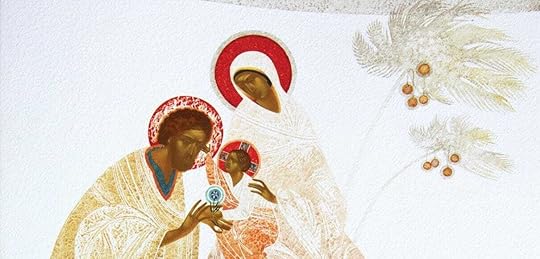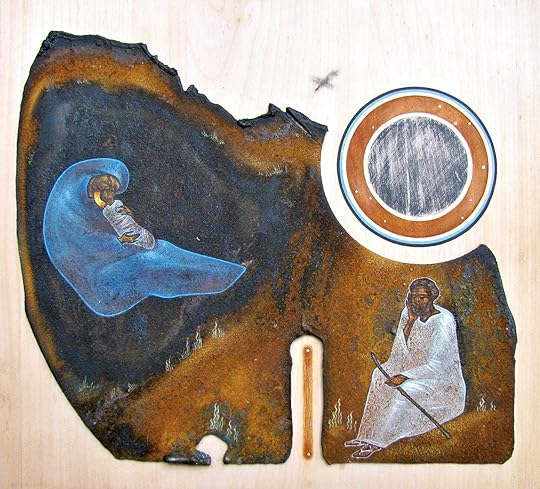Veiled in Bread, the Godhead See

Thanks for reading Jason Micheli ! Subscribe for free to receive new posts and support my work.
Christmas Eve: Isaiah 9.2-7, Matthew 2.1-18
The gospel story begins with the nativity of our Lord Jesus Christ, but the gospel message began with the news of his resurrection. So:
Alleluia, Christ is Risen!
He is Risen indeed!
Now— this is important— I do not believe that God resurrected Jesus. I do not believe that Mary’s child is alive just because the gospels report it. I believe Jesus is Risen, I believe Christ is alive, because I’ve met him. I’ve met him. I know God raised Jesus from the dead because I’ve met the Risen Jesus; therefore, I trust the gospels’s testimony. Likewise, I trust Matthew and Luke and John when they bear witness to his advent into our world.
When it comes to the gospels, I apply what biblical scholars call a hermeneutic of trust; nevertheless, such trust in the stories of the incarnation does not make it any easier to convey the mystery of the incarnation. St. Anselm of Canterbury, a medieval monk, lamented in his famous book, Cur Deus Homo, “The unbelieving ridicule our lack of sophistication and accuse us of dishonoring God when we say God was born of Mary…” In his Church Dogmatics, the theologian Karl Barth warned preachers,
“At all costs we must make it clear that an ultimate mystery is involved here. It can be contemplated, acknowledged, worshipped, and confessed as such, but it cannot be solved, or transformed into a non-mystery. Upon no consideration must it be treated in a such a way that the mystery is resolved away.”
A teacher of mine, Robert Jenson, writes that “the mystery of the incarnation can only be expressed in paradoxical language.” Meanwhile, in his Small Catechism the Protestant Reformer Martin Luther instructs preachers,
Incarnation: Two what’s in a single who.“Whatever is presented to us in words must be reduced to pictures, for without a picture we can neither think nor understand anything. That is how Christ everywhere in the Gospel carries out his ministry. He taught people the mysteries of the Kingdom of Heaven by means of pictures and parables.”
The finite containing the infinite.
The humanity of God.
Eternity taking on time.
Mary giving birth to her Maker.
There is simply no way to capture and convey adequately the mystery of Christmas. All we can do, Luther insists, is paint pictures and tell stories. Nor can we merely retell the ancient text. Exactly because the gospel is a present-tense promise, it can never be proclaimed in the same way today as yesterday. The everliving gospel must always be proclaimed anew, but when it comes to the mystery at the heart of the gospel, the best we can do is draw pictures and tell stories.
Here’s a story.
It’s a story that shows what is terrifyingly and horrifyingly wrong about our world. Yet it is also— you’ve got to trust me— a Christmas story; or rather, it’s a story that helps us glimpse, as though through a glass dimly, the mystery of Christmas.
Tonight, at the top of the twenty-four story high-rise in North Kensington, West London, a banner— six stories tall— wraps around all four sides of the building.
The banner reads, “Grenfell: Forever in Our Hearts.”
Grenfell Tower is still clad in white plastic sheeting. Five years ago, on June 14, 2017, a fire broke out in Grenfell Tower. It was England’s deadliest residential fire since World War II. Seventy-two residents and fire fighters lost their lives. The fire spread with haste due to the lax building regulations which allowed builders to use an especially flammable material for the tower’s facade. An American company, Arconic, sold the material to the construction company despite knowing the risks their product posed. High rents, a lack of affordable housing, and inadequate public housing meant that Grenfell Tower was overcrowded with occupants.
Edward Daffern, a retired activist who had lived in Grenfell Tower for seventeen years, told the NY Times, “This was a whole community that was being treated with injustice and discrimination.” For instance, the tower, whose residents were primarily working class and immigrants, had only a single staircase and no sprinklers and fire alarms. The sole elevator in the high-rise had been broken for as long as anyone could remember. Forty-five year old Natasha Elcock lived on the top floor of Grenfell Tower. After the fire, she says, she was left all alone, forced to fend for herself as the local government had taken no measures to provide temporary housing. Another resident, Bellal El Guenuni, who lived in the tower with his wife and three young children, explained to a reporter that “in low income housing, I think there’s an element of ‘Be grateful for what you’ve got. Keep your mouth shut and don’t rock the boat.’”
On the sidewalk far below the banner that reads “Forever in Our Hearts,” a square canvas sign hangs in the middle of a memorial to the victims. In the center of the sign it reads: “72 Souls.”
Graffitied around the number seventy-two are questions:
“Why do we the poor have to suffer once again?”
“How dare they?!”
“What gives them the right to put money before our lives?”
“It was like time stood still,” said Marcio Gomes. Gomes lived on the twenty-first floor of Grenfell Tower with his pregnant partner and their two little girls. After attempting to call 999 five times to no avail, Gomes and his family climbed down the stairs through the heat and the smoke.
Gomes remembers that as they left their apartment he turned around to see the ceiling fall in and fire consume the manger— I mean, the bassinette— he’d just bought for his coming baby.

The Gospel of John does not proclaim the mystery of Christmas with dreams and nightmares as Matthew’s Gospel does. John does not speak of angels and shepherds like Luke. The evangelist John ignores Luther’s advice altogether and doesn’t tell a story or paint a picture. John keeps it theological,
“In the beginning was the Word, and the Word was with God, and the Word was God. He was in the beginning with God. All things came into being through him, and without him not one thing came into being…And the Word became flesh and lived among us, and we have seen his glory, the glory as of a father’s only son, full of grace and truth.”
Take note—
John does not proclaim, “The Word became human.”
Anthropos.
John proclaims, “The Word became sarx.”
Flesh.
Here’s what you may not know.
In the New Testament, flesh is not at all a positive word. Flesh is not even a neutral word. All across scripture, flesh refers not to humanity generally or generically but to humanity under the judgment and verdict of God.“Flesh,” says Barth, “is the concrete form of human nature marked by Adam’s fall.” Flesh refers to humanity in opposition to God, humanity in rebellion from God, humanity as adversary against God. In other words, in Jesus Christ, God condescends not to the world that he created; but rather, at the incarnation God enters the world that we have made in our image.
A world of avarice and indifference.
A world of despots, of Herods and Putins.
A world where innocents are killed in places like Bethlehem and Bucha.
A world where you’re never very far from a place like Ramah.
A world where you can always find a Rachel weeping for her children.
If you can stand to listen.
A world of deep darkness.
And tramping warriors.
And garments soiled in blood.
God enters that world.
The Word comes to flesh.
And God comes not as a warrior. God comes as Jesus Christ— and not as a fully-grown, self-reliant Jesus. God comes as a newborn too weak even to hold up his head, too vulnerable to left alone. The Infinite comes in this most finite of creatures.
Incarnation.
It’s a “prime mystery,” Karl Barth says, “a datum with no point of connection.” All we can do is paint pictures and tell stories.

As fire crews arrived at the Grenfell Tower blaze, they quickly assessed the situation before them and the odds against them. The building could easily collapse. Their oxygen tanks lacked the air supply necessary to climb up to the top floors of the high-rise. Anything could wrong. They were as likely to die as save anyone. Nevertheless, not one of the firefighters flinched when it came to going in, going up. Many climbed up several times.
Knowing the danger they were accepting, understanding the risks they were assuming, seeing the sheer vulnerability they were entering, the firefighters all took a moment and wrote their names on their helmets (so that their bodies could be identified), and then they all hugged one another tightly, a frantic, fearful embrace because few of them believed they would make it out alive.
Now—
Imagine, paint a picture in your mind, the three persons of the Godhead wrapped in a similarly tight embrace.
Imagine Father, Son, and Holy Spirit in a desperate, fearful grasp of one another in the moments just before the Father’s only begotten Son becomes incarnate in Mary’s belly.That danger, that risk, that absolute vulnerability— that’s what the Gospel wants you to hear in that little phrase about a tiny baby, “And the Word became flesh.”Surely at least one angel in the heavenly host protested, “Are you crazy?! They’re liable to kill you!”
At North Kensington in West London, the fire crews climbed up into the unknown.In Bethlehem, the Love with which we are loved came down.Love came down into a situation every bit as precarious and risky. He can’t even feed himself much less defend himself.
Here God is:
In the hands of poor, inexperienced parents, soon to sneak across the border.
At the feet of dumb, clumsy animals.
Under a ramshackle roof.
Exposed to the elements.
Approached by strangers.
Hunted by a despot with a cosmic authority problem.
It could’ve gone wrong in a thousand different ways. It’s a miracle he made it to the terrible twos. God imperils his very self in order to be cradled in Mary’s arms.
God risks everything in order to be not just the Subject of our lives but the object of our love, to be God-with-us.Only—
God doesn’t come down in the flesh as an answer to a 911 call.
According to Ephesians, it is God’s choice “from before the foundation of the world.”
The incarnation isn’t an emergency response.
According to scripture, it is God’s choice, “The mystery of his eternal will…set forth in Christ…just as to unite all things in the fullness of time.”
Christmas isn’t God’s Plan B.
According the Bible, God’s gracious election of us in Jesus Christ is
“the beginning of all the ways and works of God.”
I’m going to say that again because it’s absolutely everything.
God’s decision to be with you and for you is the beginning of all the ways and works of God, before the Big Bang even.It’s as though far above the disaster zone called this world of flesh, there is— indeed, there has always been; there has never not been— a banner hanging from the Trinity’s penthouse in heaven that reads, “You are in our hearts forever.”
At Christmas, the Church makes such an astonishing assertion that it robs everyone of the possibility of neutrality on Christianity.
This is the claim:
There is no other God but the God who has determined himself not to be God without you.
Which means, the good news of great joy isn’t that God was with us in Jesus Christ. The good news of great joy is that God is with us in Jesus Christ because there is no other God than Emmanuel and he has no other identity than God with us as Jesus.
The good news tonight is not that God was with us in Jesus Christ. The good news tonight is that God is with us in Jesus Christ.As real and visible, tangible and embodied, as the baby at Mary’s breast.
Two Sundays ago, after the Christmas Pageant, one of the children in the cast came up to me in the fellowship hall.
“I have a question,” she said.
“What’s your question?”
“So…Jesus is alive?”
I nodded. She thought about it for a moment. Clearly this hadn’t been her question.
“Well, if Jesus is alive, then how come we can’t see him?”
I knelt over and leaned in towards her and I whispered, like this was a secret too special to share.
“Actually,” I said, “you can see him; in fact, you did see him just last Sunday.”
“I did?”
I nodded.
“Yes, of course,” I said, “He was that bread on the table and the cup next to it. Jesus is alive and that’s the form— one of them, anyway— his body takes now.”
She nodded.
“Oh, cool,” she said.
And then she ran off as quickly as a magi from the manger.
The Risen Jesus himself promises, “Lo, I am with you until the end of the age.” How is he with us? “Take and eat,” Jesus instructs us, “This is my body…” With you. For you.
I know what you’re thinking.
“Would Almighty God really let his body be pushed around on the Supper’s table, or handed over to sinners and all sundry who come?”
The question is logically ironic. To answer “No,” (No, God wouldn’t assume such ordinary creatureliness and give himself over to those who take him for granted) is already to posit a God other than the one held in manger, the same one who will hang upon a tree.
God has a body— still.“Bethlehem” means “House of Bread.” The Son still lives in bread.
Like Gandalf says to Frodo about the ring of power, he wants to be found. God wants to be seen and heard and held. God wants to be touched and tasted, born by you as much as by Mary.
God wants to be your mercy and your righteousness. You don’t have to live a perfect life; his perfect life is right here for the taking. God wants to be your righteousness. God wants to be your pardon and forgiveness. God wants to be your comfort and joy. God wants to be your companion amidst loneliness, your calm against fear, your hope in the face of grief. God wants to be your crutch for whatever weakness— ailment or addiction— hobbles you.
You are the reason why the Son of God comes down and becomes incarnate in word and wine and bread again and again and again.
Which is to say, God wants you.
Veiled in bread, the Godhead see.
How can the Creator of all that is, seen and unseen, be a Jew who lived briefly, died violently, and rose unexpectedly?
How can the baby born in Bethlehem be here now, be ubiquitous in fact, incarnate in creatures of bread and wine?
It’s a mystery.
All we can do, Luther says, is tell stories.
And paint pictures.
So just imagine for a moment, suspended above the altar and the table, the three persons of the Trinity wrapped in a fierce embrace, clutching at one another expectantly, waiting to see if you will respond to their call and come down and receive him, to taste and see the goodness of God; so that, Mary’s child— who is your Maker— might lodge in your heart forever.
*artwork by Ivanka Demchuck
Thank you for reading Jason Micheli . This post is public so feel free to share it.
Jason Micheli's Blog
- Jason Micheli's profile
- 13 followers



